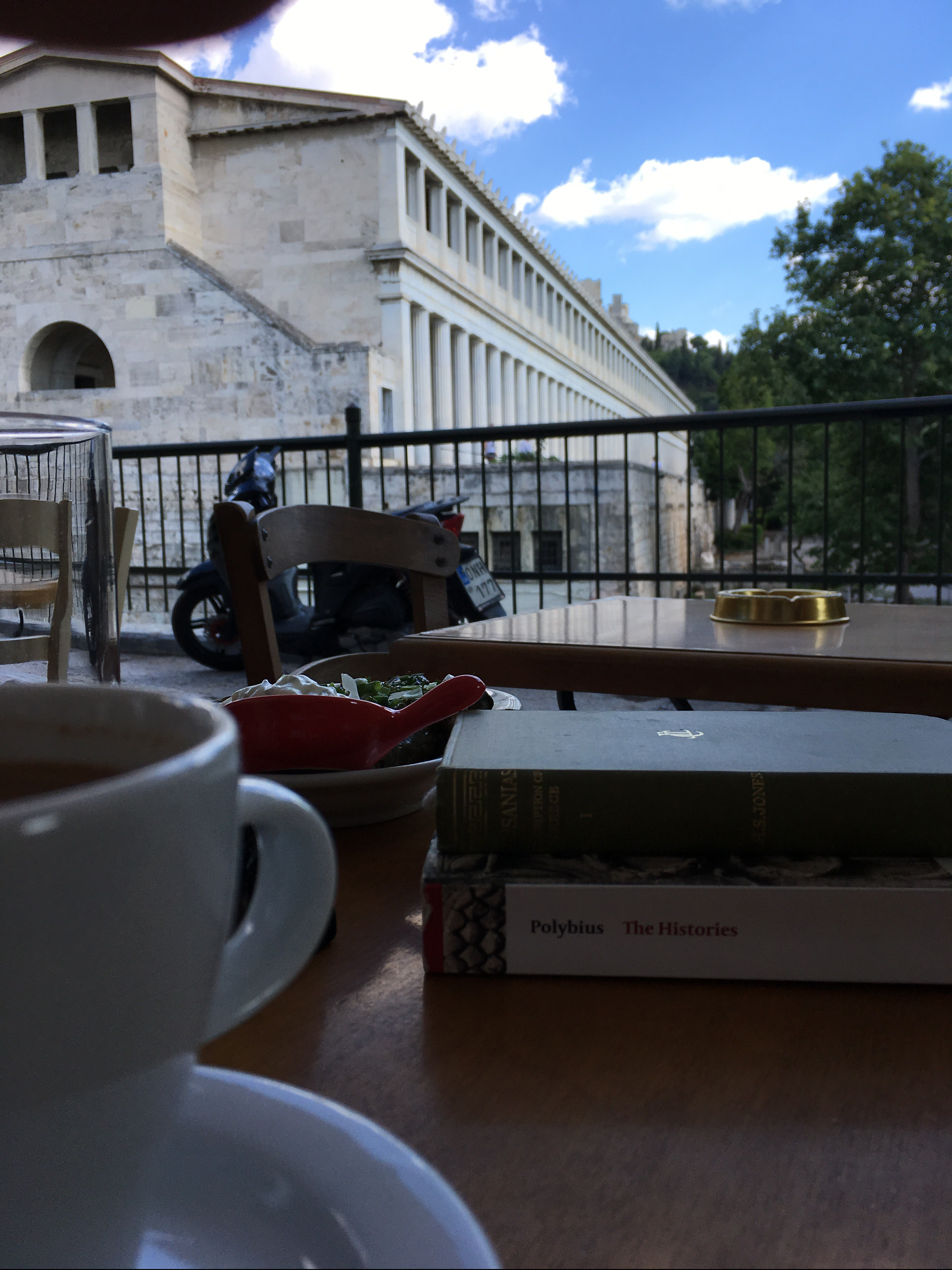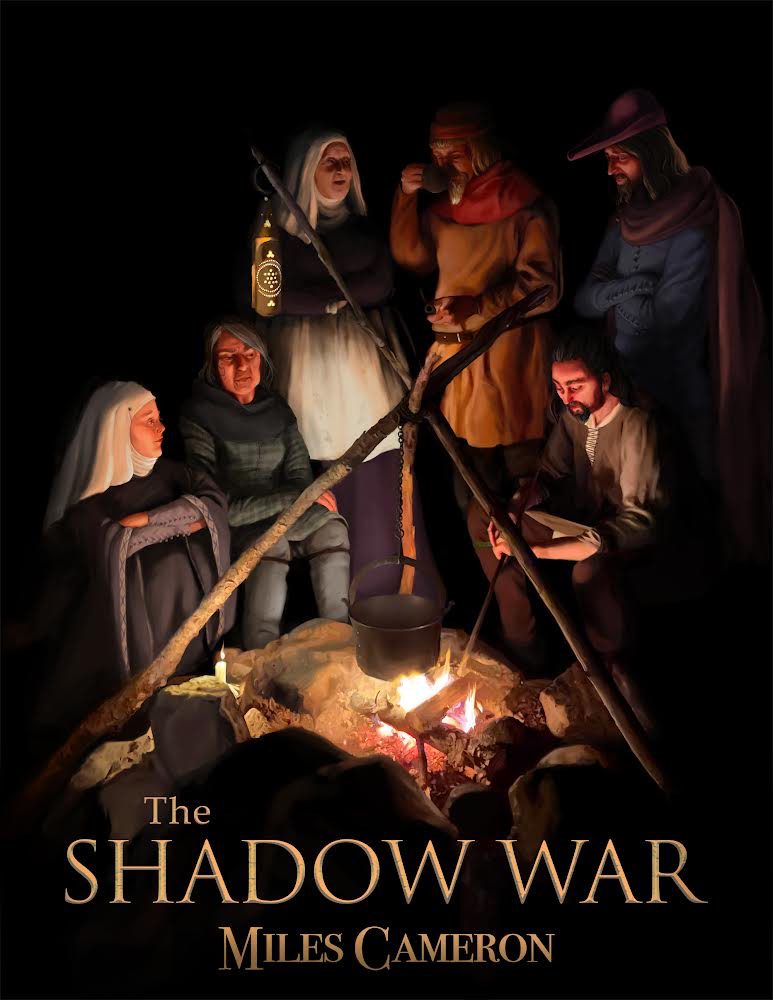
Today we are leaving Greece after a mere ten days. Our trip has been glorious; perfect weather, wonderful food, friendly people, new friends and old. For my next blog, I’ll be talking about reasons why you should visit Greece; about the tourist industry, the cleanliness, and the complete lack of refugee problems so widely advertised in the western press. That’s for another day.
For today, I’m going to continue talking about research. In my last blog* I discussed the fun and the value of learning by experience; the experience of historical swordsmanship, of Ancient Greek cooking, of dance or horseback riding or watching shepherds or rowing a warship. I love all that; in fact, I sort of make ‘experiencing the past’ my ‘lifestyle.’
But let’s be honest. There are tens of thousands of things about the past that I cannot possibly experience; or, looked at another way, I need to validate my experience by checking that experience against ground truth. The truth of the past maybe be cloudy or difficult; you can, if you wish to probe the complexity of Classical History, read the later chapters of Polybius, my current favorite ancient author. He spends quite a bit of time criticizing other ancient authors; he attacks Callisthenes description of Alexander’s Battle of Issus. Callisthenes was there; an eyewitness, unlike any account now surviving. We no longer have Callisthenes account… only that of Polybius criticizing. Interesting, eh? Especially as the careful criticisms he makes of Callisthenes account ring true, and he then goes on to assert that only those with direct experience of war can write about war, and only those with direct experience of politics can write about politics. His inference is that Callisthenes, as an educated man but not a soldier, didn’t understand Alexander’s army at all. He didn’t understand what he was seeing. Sadly, that’s all too possible, and underlines the danger of even an eyewitness account.
(And why should you care? Well, the Battle of Issus is the first scene in my first Greek novel, Tyrant, about Kineas. And then again, in ‘God of War.’ I’ve spent a lot of time looking at it…)

Hey! Don’t be bored. I realize that this isn’t knights jousting or phalanxes locked in mortal combat or Gabriel Muriens cracking wise while dealing a wyvern its death blow, but the whole key to research is in reading, and let’s face it, reading critically. You can’t believe everything you read; every author has opinions (me included) and many are fallacious (mine included). Some authors are just bent; they hate someone, so they vilify him…. Xenephon, famously, wrote his entire history without once mentioning the name of the Theban hero Epaminondas, because Xenophon loathed him for his victories over Sparta. Xenephon and Thucydides were both Athenians who wrote about Sparta with love and respect while attacking their political enemies; Livy is a zealot, Plutarch created ideal pasts to satisfy his philosophy, Froissart was a Hainaulter for whom all fellow Hainaulters were heroes, and so on.
But without them, and history’s cousin, archaeology, we would know almost nothing. Archaeology makes bold claims about veracity and the revelation of the past, but archaeologists are as human as historians and politicians; they exaggerate or underestimate, they see trends because they want to, they sometimes fail to file site reports or sometimes they’re underfunded and often they are, like anthropologists, witting or unwitting products of flawed neo-colonial thinking. Hey, when I use a word like neo-colonial, I do not mean that all history or archaeology done in the colonial era is bunk; far from it; they did some great work, and some of them were brilliant. You merely have to read them for bias. Like racism. And nationalism.

But why Pausanias in the Agora?
Sarah and I started our vacation with a side trip from the Athens airport to Sounion, the fortress-temple of Poseidon. When we were there, we opened Pausanias. His very first description is of Sounion. If you don’t know him, he’s a Roman-era eyewitness to the spendour of Classical Greek culture; he was visiting Greece when it was all still there, so to speak. And yesterday, as the sun slanted down in the peerless blue sky over the Acropolis, we sat at a café in Monastiraki and I read Pausanias about the ancient Agora. Because I am about to write a novel about Philipoemen of Achaea, and he lived in the second Century BCE; that is, about two hundred and fifty years after Arimnestos. A different Athens. Most of the vast monuments in the Athenian Agora were, in fact, completed when Philipoeman was there; whereas in the midst of the Persian Wars, Athens did not yet have a stone theater; the Parthenon was no yet built, nor was the temple of Athena Nike or the magnificent Hephaiston. In fact, almost nothing visible above ground today was there for Arimnestos! The Athens of Arimnestos had a wooden, possibly moveable theater; the acropolis had a very different temple atop it. All of that was destroyed, twice, by the Persians.
By 200 BCE, most of the glorious architecture was up; not the Tower of Winds, or some of the Roman donations, but the rest; the great stoas, the Academy and the Lyceum and all the structures that most modern tourists associate with ancient Athens. Athens was probably at its most splendid in 200 BCE, if a little past its best by date in terms of international power and prestige. (NB The Stoa of Attalos, where I started this article, was not up for Philipoemen. It wasn’t built until 159 BCE or about thurty years after his death. It is still gives a good idea of what life amidst the other stoas was like!)
Pausanias saw it all. It’s interesting to see it through his eyes; when he was in Athens, the Temple of Athena, the Parthenon, had a giant statue of the goddess made of ivory and gold; virtually every stade of ground from Piraeus to the gates had a statue by Pralixes (none survive today, although he was accounted the greatest sculptor of the ancient world.) And, if you can stand Pausanias’s endless digressions (somehow I tolerate them… takes one to know one) you can get a feel for what it all looked like when the temples and the public buildings and the art were young.
But by reading Pausanias in the agora, you can combine the two. You can lay the second-hand experience of reading over the direct experience of seeing the ruins. You can walk along the edge of the Painted Stoa, and with the help of Pausanias you can imagine what the painting of the Battle of Marathon looked like, although I promise you, as a reenactor of the Plataeans at Marathon, that I have imagined that painting a hundred times. You can imagine he Tholos as a building; you can walk in the magnificent reproduction of the Stoa of Attalos and imagine what it was like when the other stoas were up, allowing citizens to wander in the shade on the hottest day, looking at some of the most beautiful art ever created as they went about their business and the politics of their city.

It is probably impossible to faithfully and accurately reproduce the past. That’s a reality that reenactors constantly confront; the honest ones, I mean. But with patience and research and skill, it is possible to recover some of the past, and to describe it. We can’t know what the painted stoa looked like; we can’t have it back. But I can give you characters walking through it and experiencing it, and help you to see it in your minds eye.
A last digression. Inside the Stoa of Attalos reconstruction is a museum. It is a wonderful museum, dedicated to finds withing the Agora itself. It is not a huge or mind-numbing as the National Archaeological Museum, or even the Benaki. It gives representative samples of the finds across the ages, from the earliest Bronze Age occupation of the Acropolis all the way through the late middle ages, when William Gold’s friend Nerio Accaiaoli was the ‘Duke of Athens’ that we here of in Chaucer’s ‘Knight’s Tale.’ Sometimes I think that small intimate museums do a better job of telling us what things looked like; it doesn’t all become some sort of mental mush in the smaller, bite-sized pictures of the past.
At any rate; I think we can get there. Thanks to Pausanias. And archaeology. And our imaginations….


Great post, thank you! Smoking forward to tales of Philipoemen.
great post, thanks. looking forward to reading more.
What an excellent meditation!